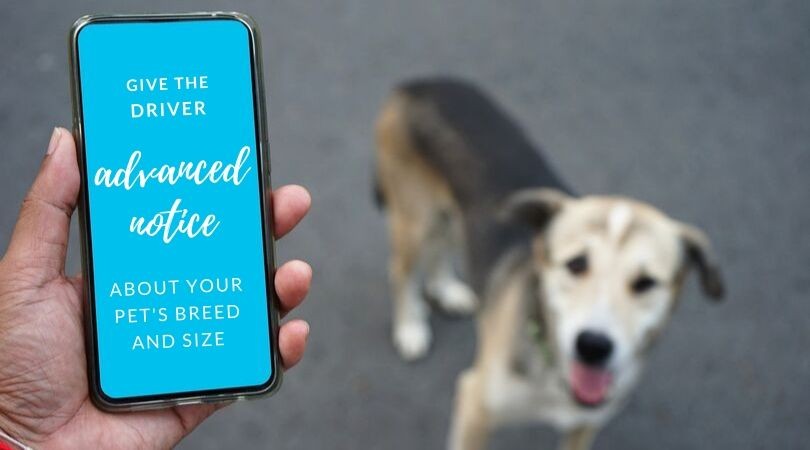Bringing your furry friend along for errands or adventures is becoming increasingly common. As ridesharing services like Uber and Lyft gain popularity over private car ownership, pet owners are naturally wondering: “Can Pets Ride In Uber?” Navigating pet transportation can be tricky when you’re not in your own vehicle. Whether you’re heading to a dog-friendly café, the vet, or simply exploring the city, understanding the rules and etiquette of bringing pets in rideshares is essential.
Service Animals vs. Emotional Support Animals: Knowing the Difference
Before diving into specific policies, it’s crucial to understand the distinction between service animals and emotional support animals (ESAs). This difference significantly impacts their accessibility in public transportation and rideshares.
According to the Americans with Disabilities Act (ADA), service animals are specifically defined as dogs individually trained to perform tasks for individuals with disabilities. These tasks can range from guiding the visually impaired to detecting seizures or providing physical support. Legally, Uber and other transportation services must accommodate service animals, regardless of their general pet policies. Denying access to a service animal is a violation of the ADA, even in “no pets” environments.
Emotional support animals, on the other hand, provide comfort and therapeutic benefits but are not trained to perform specific tasks related to a disability. The ADA explicitly states that ESAs, comfort animals, and therapy dogs do not qualify as service animals under Titles II and III of the ADA. This legal distinction means that while service animals have guaranteed access, the acceptance of ESAs and other pets in rideshares is subject to different rules.
Pets on Public Transportation: A Mixed Bag
Public transportation policies regarding pets vary widely depending on the city and the specific transit system. There’s no universal rule, making it necessary to check the regulations of your local provider.
For instance, Amtrak, the national rail service in the United States, does permit pets on certain trains, but with limitations like a maximum of four pets per train on a first-come, first-served basis. In New York City, the Metropolitan Transportation Authority (MTA) requires pets to be “enclosed in a container and carried in a manner which would not annoy other passengers” across all subway and bus lines. San Francisco’s public transportation has a more lenient approach; while pets aren’t required to be in carriers, dogs must be leashed and muzzled for safety on cable cars, MUNI buses, and subways.
Therefore, if you’re considering public transportation with your pet, thorough research is key. Always verify the pet policy of the specific bus, train, or subway system you plan to use beforehand to avoid any unexpected issues. Consider these general tips for public transit with pets:
- Pet Socialization: Ensure your pet is well-socialized and comfortable around strangers and other animals to minimize stress and potential disturbances during the journey.
- Health Documentation: Carry proof of your pet’s up-to-date vaccinations and health records. This might be required by some transportation services or helpful in case of any unforeseen incidents.
- Policy Verification: Always double-check the specific pet policy before your trip. Some systems may have restrictions on carrier types (hard vs. soft), require muzzles, or impose additional fees.
Navigating Uber and Lyft Pet Policies
Uber and Lyft, as prominent rideshare platforms, have similar approaches to pets. Officially, their policies state that service animals are always welcome. However, when it comes to non-service animals, including emotional support animals and typical pets, the decision largely rests with the individual driver.
According to Uber’s guidelines, drivers have the discretion to accept or decline pets (excluding service animals). This means that while there isn’t a blanket “no pets” rule, you’ll need to get driver approval for each ride. Lyft operates under a comparable system, leaving pet acceptance to the driver’s judgment, except for service animals which are always permitted.
To increase your chances of a successful ride with your pet in an Uber or Lyft, consider these strategies:
- Advanced Driver Notification: As soon as you request a ride, use the app’s messaging or calling feature to inform your driver that you are traveling with a pet. Uber recommends providing details about your pet’s breed and size to help the driver assess if their vehicle is suitable. Early communication sets expectations and allows the driver to decide in advance.
 Dog owner looking at smartphone screen
Dog owner looking at smartphone screen
- Pre-Ride Exercise: Before your ride, take your dog for a walk or engage in some playtime. This helps them relieve themselves before getting into the car and expend some energy, making them more likely to relax during the journey. A calmer pet makes for a more pleasant experience for everyone.
- Vehicle Protection Measures: Bring a blanket, towel, or pet carrier to protect the driver’s vehicle from pet hair, dirt, or accidents. For smaller pets, a carrier is often the best option. Informing the driver that you’re prepared to protect their car can significantly increase their willingness to accept your pet. It shows responsibility and consideration for their vehicle.
- Express Gratitude: If a driver accommodates you and your pet, show your appreciation. A larger tip than usual and a positive review are excellent ways to thank them. Good reviews are crucial for rideshare drivers, and acknowledging their flexibility with a top rating can encourage pet-friendly practices within the rideshare community.
Making Pet Rideshare Travel Work for You
Traveling with your pet in an Uber or Lyft is definitely possible with the right approach. While it requires a bit more planning and communication than traveling alone, it can be a convenient option for pet owners without private vehicles. By understanding the policies, communicating proactively with drivers, and being a considerate pet passenger, you can make “ruff” rides rewarding for both you and your furry companion. Remember to always prioritize your pet’s comfort and safety, and pack essentials like treats or a familiar toy to help them stay calm and content during the ride.